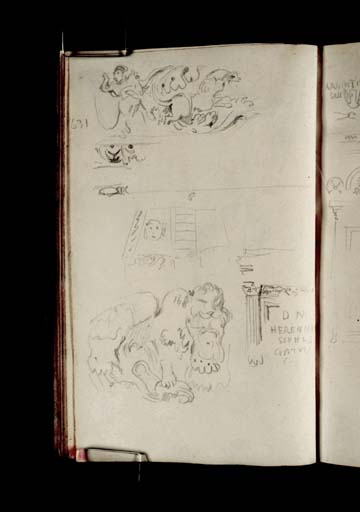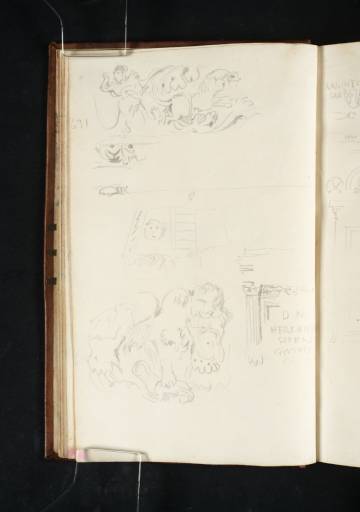Joseph Mallord William Turner Studies of Sculptural Fragments and Reliefs from the Vatican Museums, Including a Detail of a Lion Devouring a Horse from a Sarcophagus, and Part of the Funerary Altar of Herennia Sophe 1819
Image 1 of 2
-
 Joseph Mallord William Turner, Studies of Sculptural Fragments and Reliefs from the Vatican Museums, Including a Detail of a Lion Devouring a Horse from a Sarcophagus, and Part of the Funerary Altar of Herennia Sophe 1819
Joseph Mallord William Turner, Studies of Sculptural Fragments and Reliefs from the Vatican Museums, Including a Detail of a Lion Devouring a Horse from a Sarcophagus, and Part of the Funerary Altar of Herennia Sophe 1819 -
 Joseph Mallord William Turner, Studies of Sculptural Fragments and Reliefs from the Vatican Museums, Including a Detail of a Lion Devouring a Horse from a Sarcophagus, and Part of the Funerary Altar of Herennia Sophe 1819 (Enhanced image)Enhanced image
Joseph Mallord William Turner, Studies of Sculptural Fragments and Reliefs from the Vatican Museums, Including a Detail of a Lion Devouring a Horse from a Sarcophagus, and Part of the Funerary Altar of Herennia Sophe 1819 (Enhanced image)Enhanced image
Joseph Mallord William Turner,
Studies of Sculptural Fragments and Reliefs from the Vatican Museums, Including a Detail of a Lion Devouring a Horse from a Sarcophagus, and Part of the Funerary Altar of Herennia Sophe
1819
Joseph Mallord William Turner 1775–1851
Folio 8 Verso:
Studies of Sculptural Fragments and Reliefs from the Vatican Museums, Including a Detail of a Lion Devouring a Horse from a Sarcophagus, and Part of the Funerary Altar of Herennia Sophe 1819
D15118
Turner Bequest CLXXX 7 a
Turner Bequest CLXXX 7 a
Pencil on white wove paper, 161 x 101 mm
Inscribed by the artist in pencil (see main catalogue entry)
Accepted by the nation as part of the Turner Bequest 1856
References
1909
A.J. Finberg, A Complete Inventory of the Drawings of the Turner Bequest, London 1909, vol.I, p.531, as ‘Various relivos; probably in Vatican; one of an animal among foliage numbered “631”. Another fragment “168” ’.
1984
Cecilia Powell, ‘Turner on Classic Ground: His Visits to Central and Southern Italy and Related Paintings and Drawings’, unpublished Ph.D thesis, Courtauld Institute of Art, University of London 1984, pp.412, 476 note 8, as ‘(d) Part of the funerary altar of Herennia Sophe (A, I, Glap, 26, not ill.)’.
1987
Cecilia Powell, Turner in the South: Rome, Naples, Florence, New Haven and London 1987, p.51 note 6.
During his 1819 stay in Rome, one of Turner’s most extensive sketching campaigns was the large number of pencil studies made from the sculpture collections of the Vatican Museums (for a general discussion, see the introduction to the sketchbook). This page contains sketches of various objects, most or all of which were probably found in the Galleria Lapidaria (Lapidary Gallery) of the Museo Chiaramonti. The studies are numbered from top left to bottom right:
a.
Sketches from an unidentified monument including part of a sculptural relief with figures and a stylised leaf motif, and details recording the ornamental border beneath. The object is inscribed with the number ‘631’ along the left-hand edge.
b.
An unidentified object inscribed ‘8’.
c.
In the bottom left-hand corner is a detail of a lion devouring a horse from a fragment of a large sarcophagus formerly in the Galleria Lapidaria (Lapidary Gallery).1 Today it can be found in the Northern Portico of the Cortile Ottagono (also known as the Cortile Ottagonale, formerly the Cortile del Belvedere) in the Museo Pio-Clementino.2 The sketch is inscribed with the number ‘168’.
d.
Cecilia Powell has identified the study in the bottom right-hand corner as part of the funerary altar of Herennia Sophe,3 from the Galleria Lapidaria (Lapidary Gallery) of the Museo Chiaramonti.4 Turner has transcribed the Latin text from the object as ‘DM | HERENNIA | SOPHES | [?ANIVCI]’. The first part translates as ‘D[is] M[anibus]’, ‘To the spirits of the departed’, and is a common phrase found on Roman funerary monuments.
Sketches from an unidentified monument including part of a sculptural relief with figures and a stylised leaf motif, and details recording the ornamental border beneath. The object is inscribed with the number ‘631’ along the left-hand edge.
b.
An unidentified object inscribed ‘8’.
c.
In the bottom left-hand corner is a detail of a lion devouring a horse from a fragment of a large sarcophagus formerly in the Galleria Lapidaria (Lapidary Gallery).1 Today it can be found in the Northern Portico of the Cortile Ottagono (also known as the Cortile Ottagonale, formerly the Cortile del Belvedere) in the Museo Pio-Clementino.2 The sketch is inscribed with the number ‘168’.
d.
Cecilia Powell has identified the study in the bottom right-hand corner as part of the funerary altar of Herennia Sophe,3 from the Galleria Lapidaria (Lapidary Gallery) of the Museo Chiaramonti.4 Turner has transcribed the Latin text from the object as ‘DM | HERENNIA | SOPHES | [?ANIVCI]’. The first part translates as ‘D[is] M[anibus]’, ‘To the spirits of the departed’, and is a common phrase found on Roman funerary monuments.
Turner’s annotated numbers presumably relate to exhibit numbers displayed on the individual works. However, they do not appear to correspond to any known lists published within contemporary guide books or catalogues of the Vatican collections.
Nicola Moorby
November 2009
How to cite
Nicola Moorby, ‘Studies of Sculptural Fragments and Reliefs from the Vatican Museums, Including a Detail of a Lion Devouring a Horse from a Sarcophagus, and Part of the Funerary Altar of Herennia Sophe 1819 by Joseph Mallord William Turner’, catalogue entry, November 2009, in David Blayney Brown (ed.), J.M.W. Turner: Sketchbooks, Drawings and Watercolours, Tate Research Publication, December 2012, https://www

